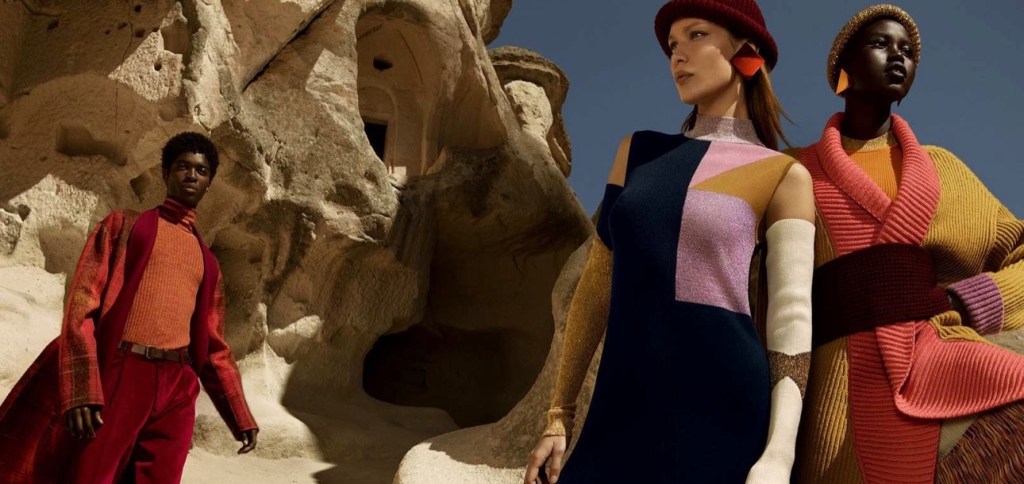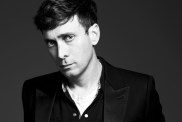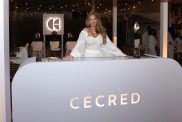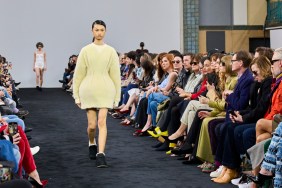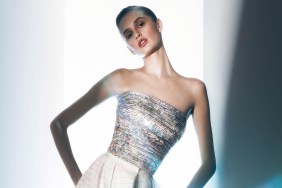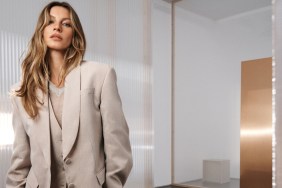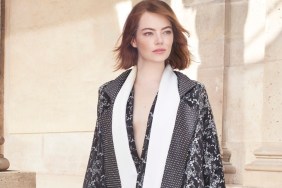Between the meteoric rise of social media and millennial consumers, the seasonal ad campaigns, fashion’s most traditional form of marketing, don’t carry the same weight they once did. With Instagram, Snapchat and the like, brands now have an immediate line to their followers, whom they interact with — and essentially pitch — on a daily, if not hourly, basis. At the same time, Gen Y consumers — according to a 2019 report by consulting firm McKinsey & Company, now the highest-spending age group in China, a key market for luxury brands — are less attracted to a single set of aspirational photos than a brand’s overall identity and messaging.
Of course, the (often high-budget) campaigns brands use to promote their warm- and cold-weather collections do provide a major opportunity to define their identity and capture their audience. Thus, the ads are a good litmus test for how the industry as a whole is doing in terms of inclusion. Here’s what our analysis of Fall 2019 fashion ads revealed.
RACE
Having examined 166 major fashion brands’ Fall 2019 campaigns, we can report that racial diversity in ad campaigns has been slowly but steadily improving since Fall 2015. Of the ads’ 464 model appearances, 39.3 percent were women of color, a 4.4 point increase over Spring 2019’s 34.9 percent. (In other words, just about two in every five models were nonwhite.) As a result, this season’s campaigns were the most racially diverse ever.

It was also the biggest spike in racial representation we’ve seen in years. Between Fall 2018 and Spring 2019, racial diversity in ads grew by only 0.4 percent, between Spring 2018 and Fall 2018 only 0.5 percent, between Fall 2017 and Spring 2018 only 1.2 percent.
What’s more, after an underwhelming Spring 2019 ad season wherein the percentage of nonwhite campaign models lagged behind the season’s more positive runway stats (36.1 percent models of color walked the Spring 2019 shows), for Fall 2019 ad campaigns once again outpaced the recent runways in terms of diverse representation. (At the risk of being repetitive, for Fall 2019 we counted 39.3 percent campaign models of color versus 38.8 percent nonwhite runway models.)
Now for the bad news. Aside from models of color, transgender and non-binary models were the only diversity category to see greater representation this ad season compared to last season. (And that’s largely because their Spring 2019 numbers were abysmally low.)
TOP MODELS
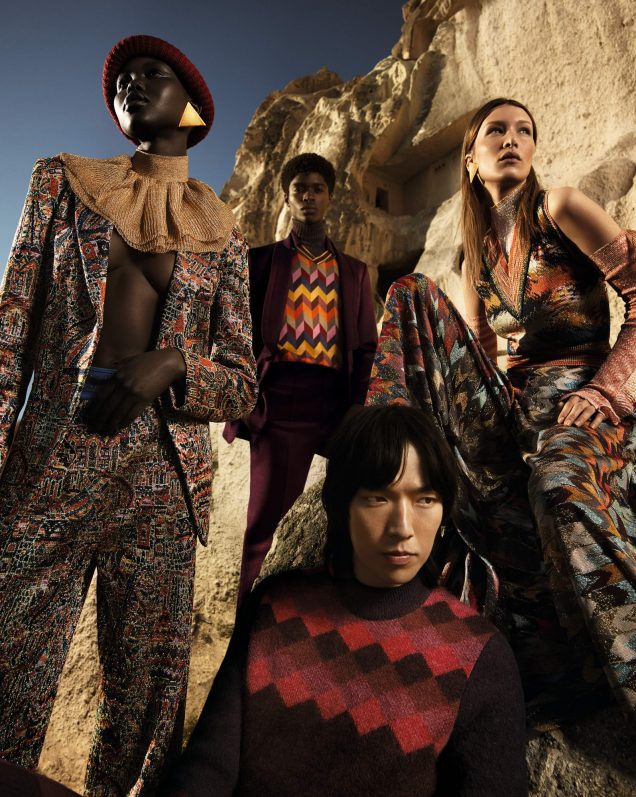
Of the five models who landed the most Fall 2019 ad campaigns, three (60 percent) were nonwhite: Adut Akech (originally from South Sudan), Anok Yai (also South Sudanese) and Mona Tougaard (who is of Somalian, Ethiopian, Danish and Turkish descent).
Akech and Anna Ewers led the group with six ad campaigns each; Yai, Tougaard and Abby Champion shared second place with five ads apiece.
PLUS-SIZE
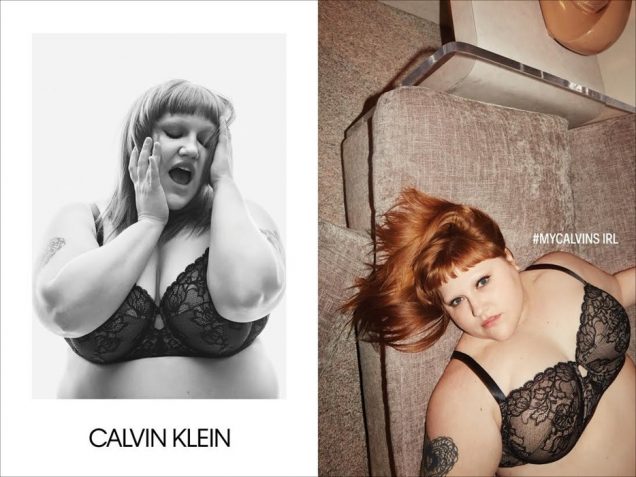
Body diversity in ad campaigns has fallen back below the 2 percent mark. For Fall 2019, only 1.94 percent of models represented in campaigns were plus-size. In other words, 9 of the season’s 464 castings went to a model in this category. That’s a slight — 0.14 percent — decrease from last season when 11 plus-size models were cast.
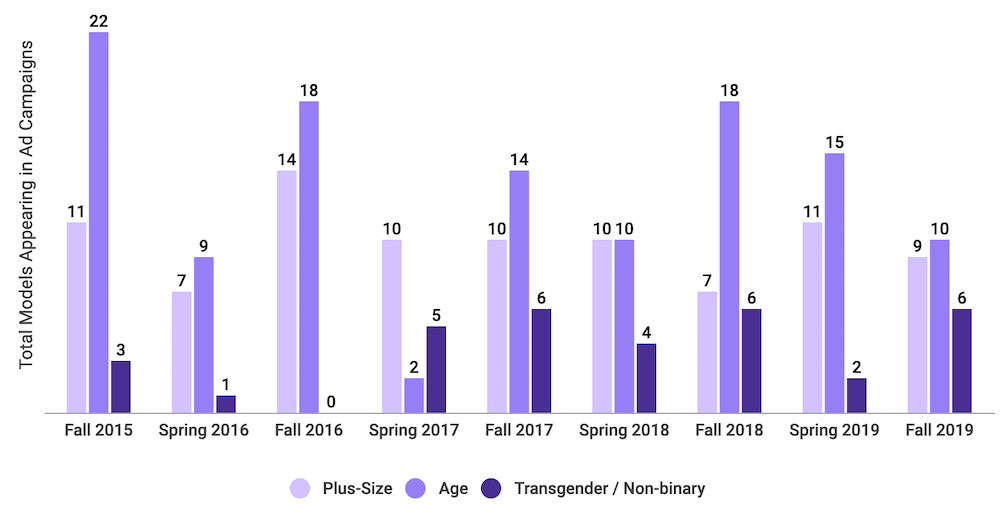
By and large, the number of plus-size women in major ad campaigns have remained mostly static over the past six seasons with the exception of Fall 2018 when casting of plus-size talent fell to its lowest point since Spring 2016. For reference, plus-size models made up 2.08 percent of castings in Spring 2019, 1.32 percent of castings in Fall 2018, 1.86 percent in Spring 2018, 2.19 percent in Fall 2017 and 2.25 percent in Spring 2017.
As to how these numbers stack up against the most recent runway stats, size representation was also down last fashion month from 0.73 percent (54 plus-size castings) in Spring 2019 to 0.69 percent (50 castings) in Fall 2019. So, relative to the runways, the ads did well in terms of size inclusion in that they at least passed the 1 percent mark.
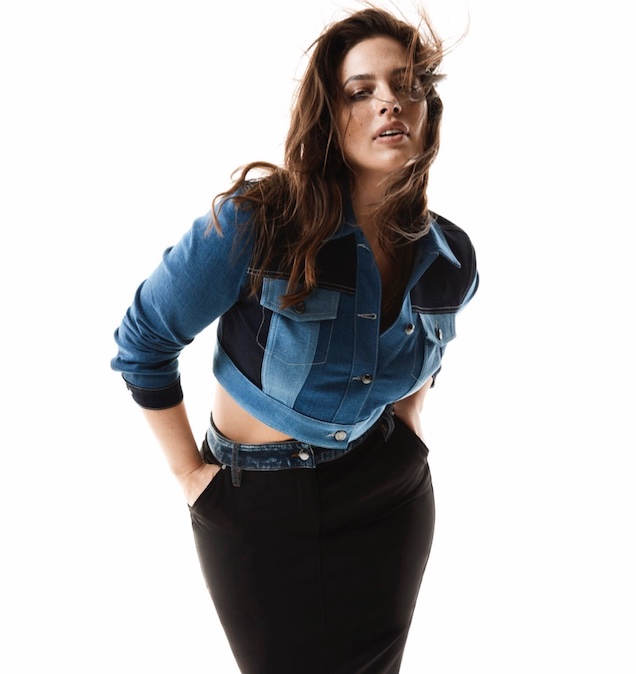
In keeping with a seasons long trend, mass-market brands were responsible for the majority (five) of Fall 2019’s non-straight-size castings. Among the more notable were Paloma Elsesser for Anthropologie and Bloomingdale’s and Lorena Duran for Victoria’s Secret, the brand’s first-ever plus-size hire. (The lingerie giant is striving to rebuild its image in the wake of former chief marketing officer Ed Razek’s exclusionary remarks; it likewise cast its first openly transgender model, Valentina Sampaio, in early August.) In a refreshing turn of events, only one of fall’s plus-size castings — Ashley Graham for Marina Rinaldi — came from a plus-specific brand.
Meanwhile, only two luxury brands — one fewer than last season — featured any body diversity in their campaigns. For the second time in a year, Calvin Klein Underwear put forth the most size-inclusive campaign of the season. It starred, among others, Beth Ditto and Hayley Foster. And Veronica Beard cast Candice Huffine.
Of the season’s nine plus-size hires, four were models of color. All were under age 50 and openly identify as cisgender.
TRANSGENDER/NON-BINARY
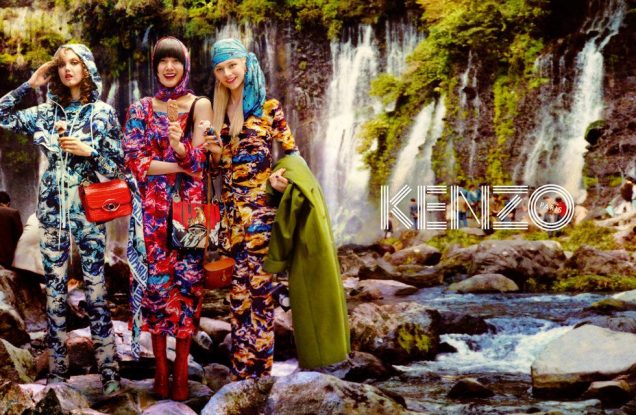
At least Fall 2019’s campaigns were somewhat encouraging when it came to gender diversity. Coming back from a regressive Spring 2019 season where only two openly male-to-female transgender or non-binary models landed campaigns (0.38 percent) — four fewer than during the season prior (1.13 percent) — the Fall 2019 ads examined in this report featured a total of six openly transgender women (1.29 percent). That’s a 0.91 percent increase from Spring 2019.
And yet, despite being the only category outside of models of color to see any improvement in representation, MTF transgender and gender nonconforming models remained the most underrepresented group, as has historically been the case. (With the exception of Spring 2017, which saw five MTF transgender or non-binary campaign castings, but only two in the 50-and-above category.)
Sadly enough, brands’ reluctance to hang campaigns on transgender and non-binary models is so great that Fall 2019’s slight improvement in trans visibility actually made it the second-most gender-inclusive campaign season to date. (By a hair: transgender and non-binary models appeared in 1.31 percent of the castings for Fall 2017 campaigns.)
Tiny though it was, the Fall 2019 ads’ 1.29 percent inclusion rate actually topped that of the corresponding show season. Only 0.77 percent of Fall 2019 runway castings went to models in this category — and that was a 0.46 percent decrease from the previous runway season.
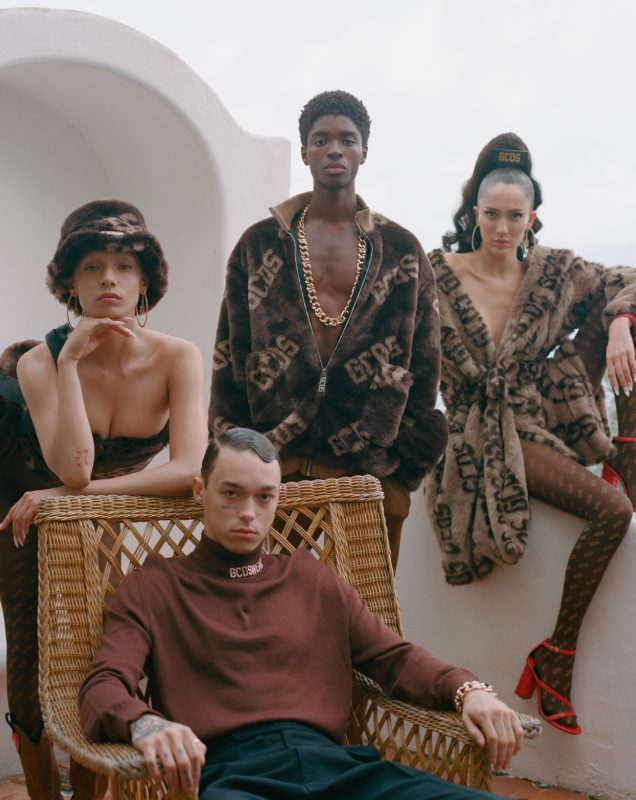
With two contracts each, Teddy Quinlivan and Valentina Sampaio were the season’s most-booked openly transgender models. Quinlivan appeared in ads for Lacoste and made-in-Italy streetwear brand GCDS, Sampaio for luxury Italian brands Borsalino and Pollini.
Rounding out the group were Hunter Schafer (of HBO’s Euphoria) and Lea T (muse to Riccardo Tisci). The former starred in Kenzo’s David LaChapelle-lensed campaign; the latter was the only openly transgender model of color to appear in a fall ad (for Saks).
Encouragingly, all of fall’s gender-inclusive castings came from luxury fashion companies. Discouragingly, not one brand hired a transgender model aged 50 or above or larger than a size 8. Not to mention their casting choices smacked of tokenism: two-thirds of the spots went to the same two models. Just as with cisgender women, there seems to be an industry preference for those who adhere to traditional beauty standards (in other words, young, tall, thin and, for the most part, white).
Nevertheless, by the numbers alone it’s clear transgender and non-binary people are becoming more visible in advertising.
AGE
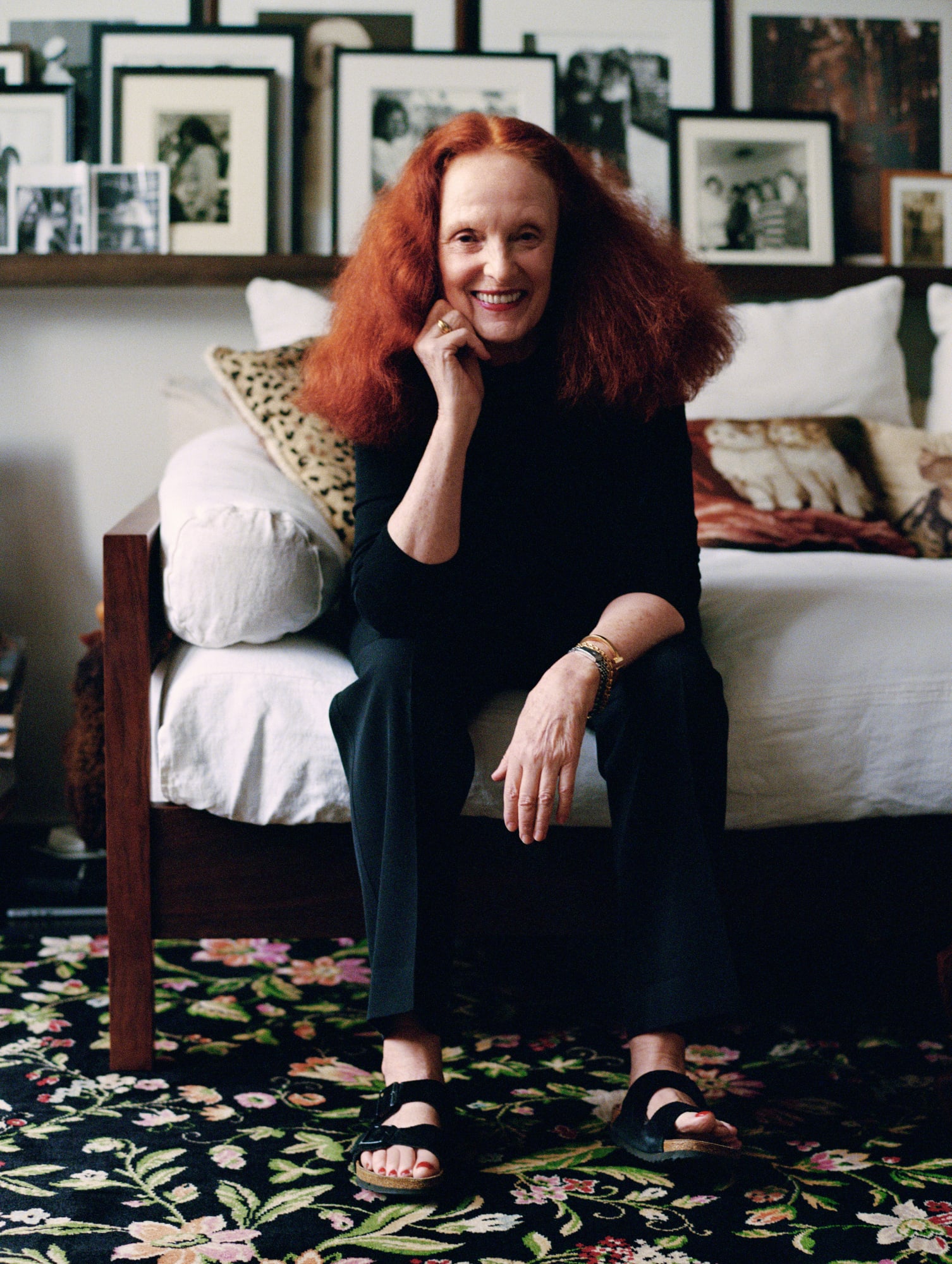
Women age 50 and above also saw a decrease in campaign representation this season as compared to last. In fact, hiring of models in this category fell to its lowest point since Spring 2018.
For Fall 2019, 10 models in the age group starred in a total of eight campaigns, making up a mere 2.16 percent of castings. For comparison, that’s five models, two campaigns and 0.68 percent below Spring 2019’s figures and a significant drop-off from Fall 2018, when 18 models age 50 and over were cast across 11 campaigns (3.4 percent).
Still, Fall 2019 wasn’t the least age-diverse campaign season on record. That honor goes to Spring 2017 when just two models age 50 and over were cast (0.45 percent).
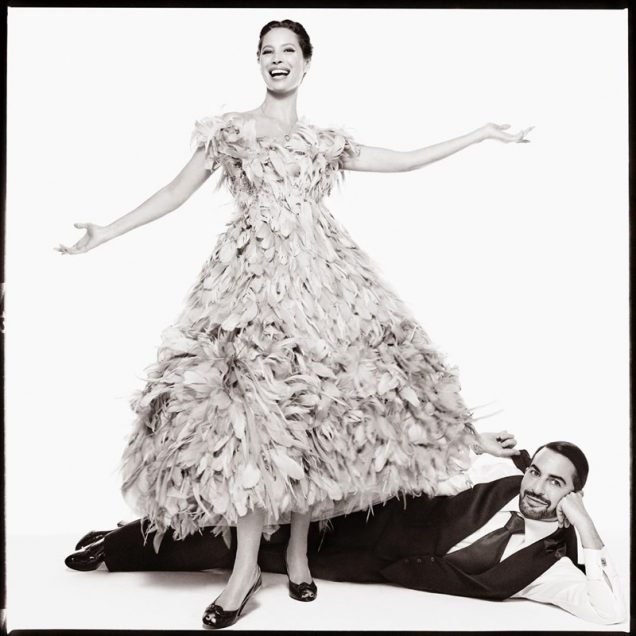
This recent decline in 50-and-over campaign castings is all the more disappointing considering the corresponding runway season saw more 50-plus models cast than ever before (36). That said, the actual percentage of models in this age group used in campaigns (2.16 percent) far exceeded that of the runways (0.49 percent).
On a more positive note, the majority of Fall 2019’s age-inclusive ads came from big-name fashion companies. Among the season’s more high-profile castings were supermodel and philanthropist Christy Turlington for Marc Jacobs, fashion icon Iris Apfel for Aigner, i-D co-founder Tricia Jones and Grace Coddington for Birkenstock, Marisa Berenson (of Cabaret fame) for Etro, veteran models Lauren Hutton and Roxanne Gould for Saks, their colleague Paulina Porizkova for Bloomingdale’s and designer Vivienne Westwood for, you guessed it, Vivienne Westwood. (Balenciaga’s team, known champions of this group, prioritized racial as opposed to age inclusion this season.)
When it comes to intersectionality, well, there wasn’t any. We haven’t seen a single nonwhite casting in this category since Spring 2018, nor did any campaign considered here feature a plus-size, transgender or non-binary woman in the 50-plus range.
MOST/LEAST DIVERSE CAMPAIGNS
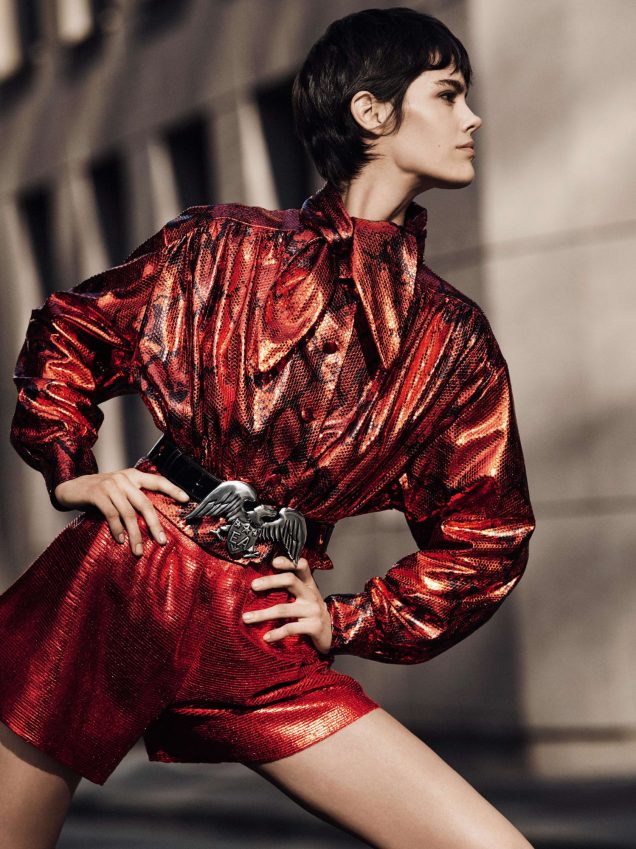
Progress is progress, but fashion’s race problem is far from solved. As proof, six ad campaigns (albeit two less than last season) still featured zero models of color in casts of three or more. Namely: Blugirl, Birkenstock, Celine, Emporio Armani, Mango and Saint Laurent. It’s always strange when huge, mass-market brands like Birkenstock and Mango fail to represent their nonwhite customer bases. (Although Birkenstock’s was one of the most age-inclusive campaigns of the season.)
Emporio Armani, Saint Laurent and Celine are all repeat offenders. To be fair, the former did make our most-diverse campaigns list as recently as Fall 2018. Saint Laurent, on the other hand, is notoriously exclusive: the brand cast no models of color in its campaigns for 14 years (between 2001 and 2015). This season, all six of its campaign stars were white. As fashion industry elites, Hedi Slimane and Anthony Vaccarello need to do better.
Moving right along, Vince, Holt Renfrew, Gerard Darel and Guess — another repeat offender — each cast only one out of five models of color (20 percent). And Etro’s fall ads featured only one nonwhite model in a lineup of six (close to 17 percent).
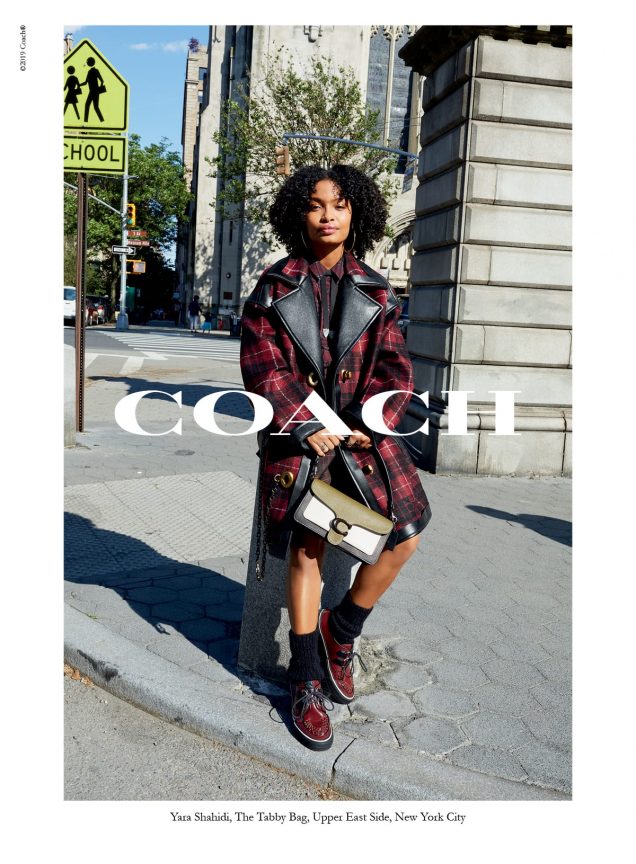
On the opposite side of the spectrum, several brands featured higher than average numbers of models of color this season. In descending order: JW Anderson (100 percent models of color), GCDS (80 percent models of color), H&M (80 percent models of color), Versace Jeans (80 percent models of color), Fenty (75 percent models of color), Coach (75 percent models of color), Y/Project (75 percent models of color), Salvatore Ferragamo (75 percent models of color), Moschino (67 percent models of color), Peacebird (67 percent models of color), Proenza Schouler (67 percent models of color), Polo Ralph Lauren (67 percent models of color), See by Chloe (67 percent models of color), Saks (64 percent models of color), Balenciaga (63 percent models of color), Reebok x Victoria Beckham (60 percent models of color), Max Mara (60 percent models of color), Kenzo (60 percent models of color), Bloomingdale’s (60 percent models of color), Dolce & Gabbana (53 percent models of color), Calvin Klein Underwear (50 percent models of color), Burberry (45 percent models of color), Miu Miu (43 percent models of color) and Prada (42 percent models of color).
Note: All of the above campaigns featured three or more models.
JW Anderson made an especially impressive turnaround: last season, the brand hired not a single model of color for its campaign. Coach (which had 67 percent models of color in Spring 2019), H&M (which had 64 percent), Prada (which had 60 percent), Miu Miu (which had 60 percent) and Calvin Klein Underwear (which had 58 percent) also deserve special recognition, having made our most-diverse list for (at least) two consecutive seasons. (It’s H&M’s third straight appearance and Coach’s fifth.)
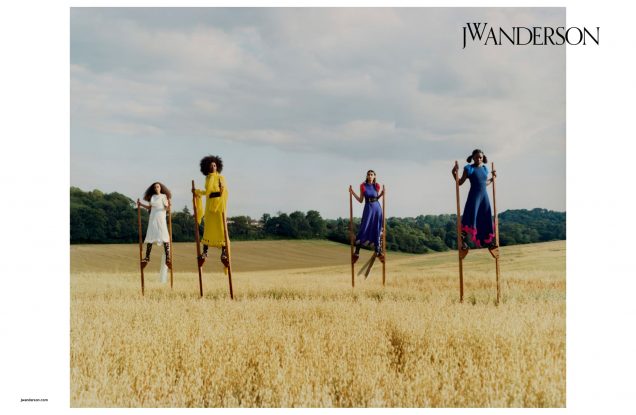
It’s also essential that we acknowledge Saks and Bloomingdale’s, which were responsible for the most all-around inclusive ads of the season. Styled by Marni Senofonte (stylist to Beyoncé and Kendall Jenner), the Fall 2019 “Mix Masters” campaign for Bloomingdale’s starred five models, 60 percent of them (three) models of color, one age 54 (Paulina Porizkova), one a plus-size model of color (Paloma Elsesser).
Released online this August and in book form September 4, Saks’ “No Apologies” campaign, lensed by Liz Collins, featured a diverse group of women in the season’s most coveted designs. Among the “inspiring women owning their power,” as Saks described them, were nine (64 percent) models of color, two women over age 50 (Lauren Hutton and Roxanne Gould) and one transgender woman of color (Lea T). (Saks was the only brand to hire a trans woman of color this season.)
Additionally, we’d be remiss not to acknowledge both Birkenstock and Calvin Klein Underwear. Though lacking in racial diversity, the former’s ads tied Saks’ for the most age-diverse of the season; the latter (which featured 50 percent models of color) was the only brand to hire more than one plus-size model, which was also the case for the Spring 2019 ad season.
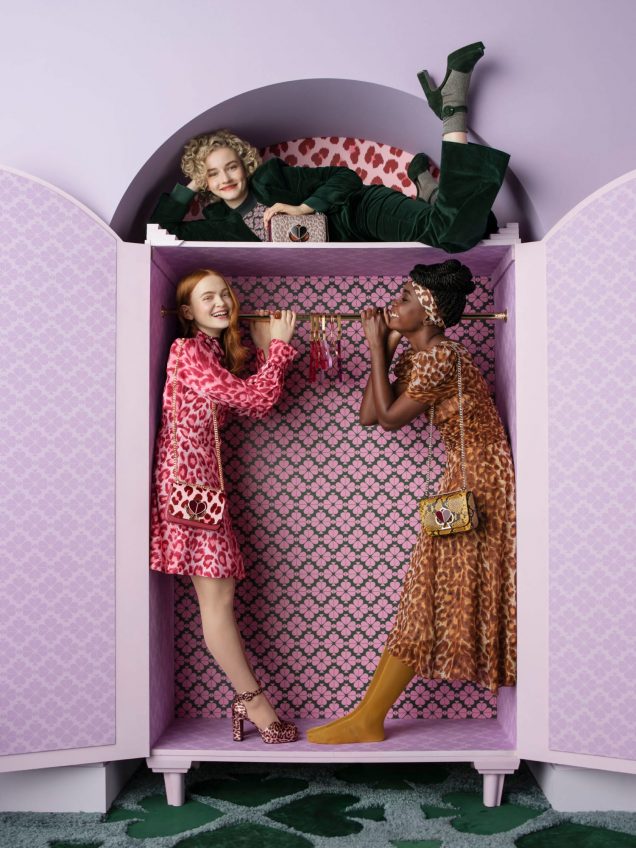
Looking at Fall 2019’s campaign imagery, it seems that, when it comes to racial inclusion, we’ve moved beyond the tipping point. With every season that passes, nonwhite models receive more and more attention from major fashion brands. That said, models age 50 and above, plus-size models and transgender and non-binary models didn’t fare nearly as well as nonwhite models at the Fall 2019 castings, once again indicating that genuine, all-around inclusion is still a ways away.
And so the industry continues along its long path of glacial change. Thankfully, we as consumers have more choice — and voice — than ever and needn’t wait patiently for establishment brands to get with the times. As former Vogue contributor Marjon Carlos put it in a recent essay: “without real inclusion, the fashion world in 2019 — the kind practiced by the main gatekeepers — feels no more relevant than it did ten years ago. In fact, it feels less relevant than ever.”
Additional reporting by Mark E.
Only women were included in the data of this report. Models of color were categorized as those of nonwhite or mixed backgrounds. The term “model” includes celebrities and influencers, sometimes referred to as nonmodels.
[ Next: Report: The Spring 2019 Ads Saw Little to No Progress on the Diversity Front ]
